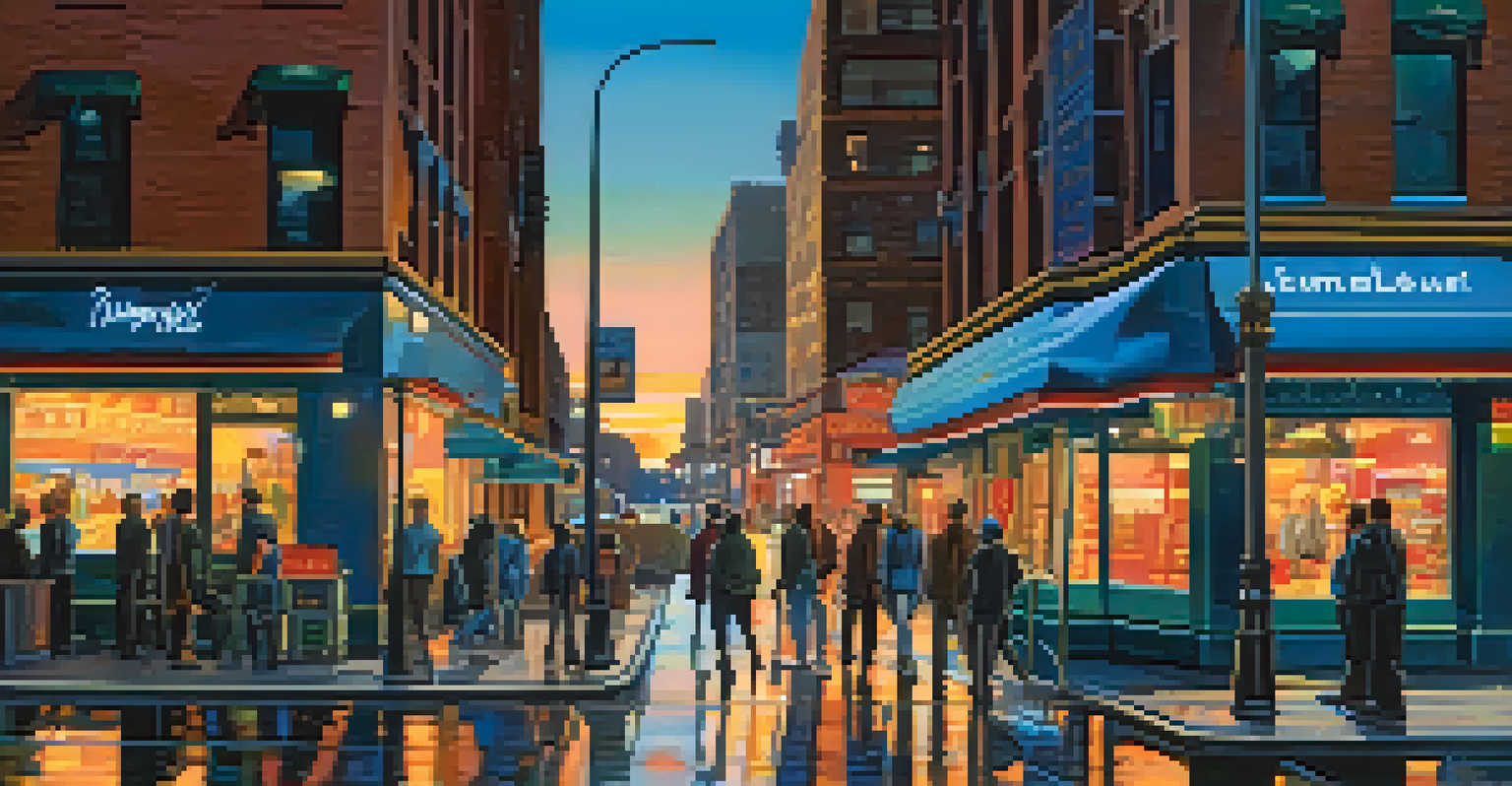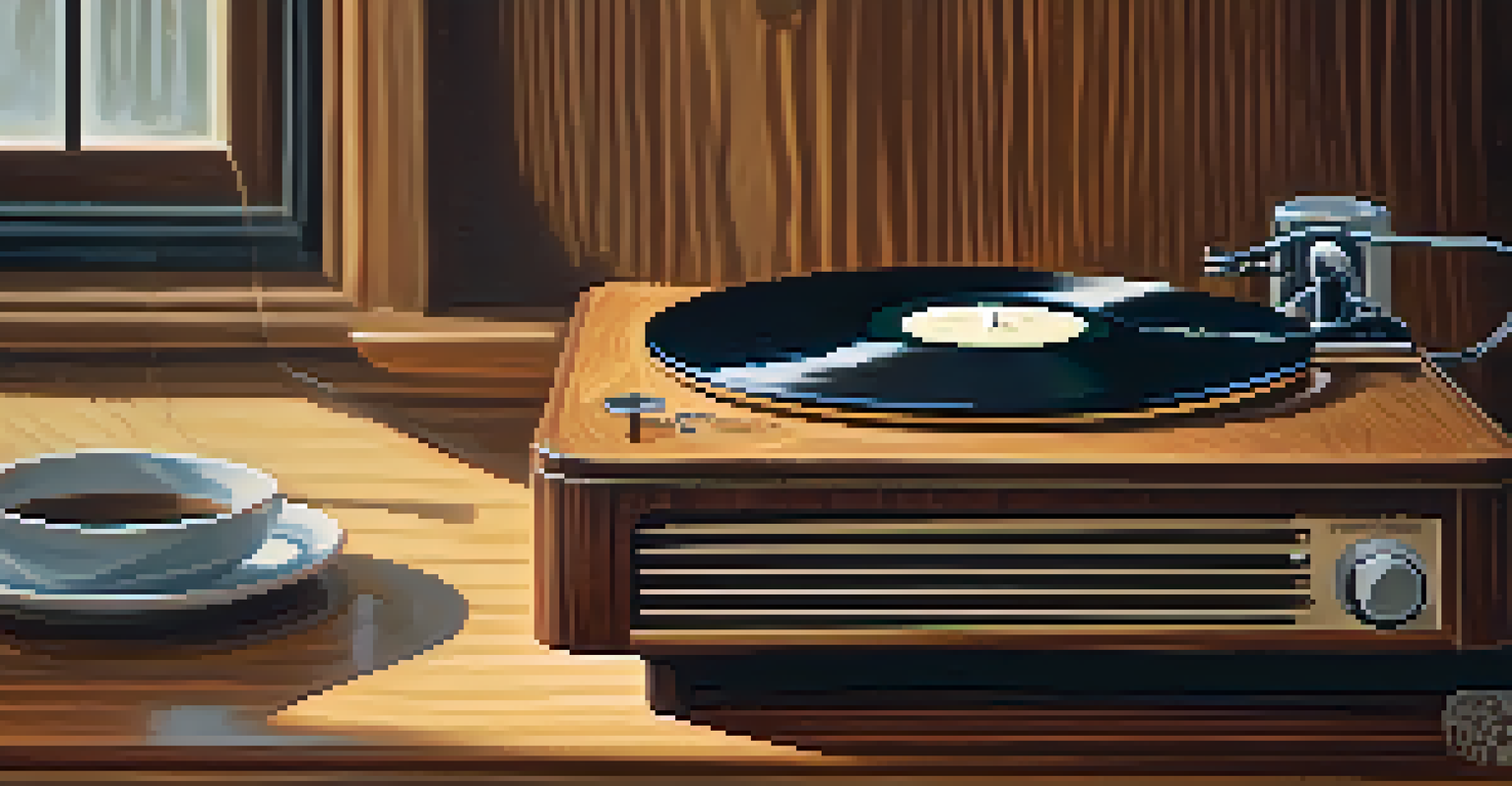Creating Dialogues: The Conversation Between Sound and Visuals

Understanding the Relationship Between Sound and Visuals
At the heart of any compelling narrative lies the intricate relationship between sound and visuals. Think about your favorite movie: the combination of visuals and sound transforms a simple story into a captivating experience. When these two elements work together seamlessly, they evoke emotions and enhance storytelling, making the audience feel as if they are part of the journey.
Sound is the vocabulary of the spirit.
For instance, consider a suspenseful scene where the sound of a heartbeat intensifies alongside the visual of a character creeping through a dark hallway. The sound amplifies the tension and keeps viewers on the edge of their seats. This interplay not only captures attention but also deepens emotional engagement, allowing viewers to experience the story more profoundly.
Ultimately, understanding this relationship is essential for creators, as it facilitates the crafting of narratives that resonate with audiences. By recognizing how sound can complement and elevate visuals, storytellers can create a more immersive experience, making every moment impactful.
The Role of Sound Design in Visual Storytelling
Sound design plays a crucial role in shaping the atmosphere of visual narratives. It’s not just about adding background music; it’s about creating a soundscape that enhances the visuals and evokes specific emotions. For example, the sound of rustling leaves can transport viewers to a serene forest, while eerie sound effects can set a haunting mood in a horror film.

Moreover, sound design helps to establish the setting and context of a scene. Imagine a bustling city scene accompanied by honking cars, chatter, and footsteps. This auditory backdrop not only paints a vivid picture but also immerses the audience in the environment, making them feel as though they are walking alongside the characters.
Sound Enhances Visual Storytelling
The interplay between sound and visuals creates a captivating narrative experience that evokes emotions and engages the audience.
By thoughtfully integrating sound elements, creators can guide the audience's emotional response and enhance the overall narrative. Sound design, when done effectively, becomes an invisible yet powerful force that shapes how visuals are perceived and experienced.
Emotional Impact: How Sound Influences Mood
Sound has a remarkable ability to influence emotions and set the mood of a visual piece. For example, a triumphant orchestral score can elevate a climactic moment, making it feel larger than life. Conversely, soft, melancholic music can evoke feelings of sadness, allowing viewers to connect with a character's struggles on a deeper level.
Music can change the world because it can change people.
Consider how a film's soundtrack can transform a scene entirely. A romantic moment underscored by a tender melody can heighten feelings of love and longing, while the same scene with no music might feel flat and unremarkable. This emotional manipulation through sound is a powerful tool in storytelling that creators can harness to leave a lasting impact on their audience.
Ultimately, the emotional resonance created by sound is what lingers with viewers long after they’ve left the theater or finished a show. By understanding how sound can evoke specific feelings, creators can craft narratives that not only entertain but also resonate with audiences on a personal level.
The Power of Silence in Visual Narratives
While sound is often celebrated for its emotional impact, silence also holds significant power in visual storytelling. Strategic use of silence can create moments of tension, reflection, or anticipation. For example, a sudden silence in a suspenseful scene can make viewers acutely aware of what’s at stake, heightening their engagement.
Silence can also allow for deeper character development. A character pausing in silence can convey their internal struggle or contemplation, inviting viewers to connect with their emotional state. This contrast between sound and silence adds depth to narratives, making them more nuanced and relatable.
Silence Adds Depth to Narratives
Strategic use of silence can build tension and allow for deeper character development, making stories more relatable.
In essence, silence can be just as expressive as sound. By embracing the quiet moments, creators can enhance the storytelling experience, offering audiences a chance to breathe and reflect on the unfolding narrative.
Using Music to Enhance Visual Themes
Music is a powerful tool that can enhance the themes of a visual narrative. The choice of genre, tempo, and instrumentation can signify different themes and emotions. For instance, a fast-paced electronic track might accompany a high-energy action scene, while a gentle piano piece may underscore a heartfelt moment, reinforcing the emotional depth of the narrative.
Moreover, recurring musical motifs can help establish a character's identity or reinforce thematic elements throughout a story. Think of iconic film scores that immediately evoke specific characters or settings, like the haunting theme of a villain that plays whenever they appear. This auditory cue not only enhances the visuals but also strengthens the connection between the audience and the story.
By thoughtfully selecting and integrating music, creators can elevate their visual narratives, making them more cohesive and impactful. Music serves as an emotional thread that ties together various elements, enriching the overall experience for viewers.
The Importance of Syncing Sound with Visuals
Syncing sound with visuals is critical for creating a believable and immersive experience. When sound effects, dialogue, and music align perfectly with the corresponding visual actions, it creates a sense of reality that draws viewers in. For instance, the sound of footsteps should match the character’s movement on-screen to maintain authenticity.
Moreover, poor syncing can disrupt the flow of a narrative and pull viewers out of the experience. Imagine watching an action scene where the sound of punches lands a second after the visual impact—this type of dissonance can confuse and frustrate the audience. Proper synchronization ensures that the audience remains engaged and invested in the story.
Future of Sound and Visuals
Emerging technologies like VR and AR are revolutionizing how sound and visuals integrate, promising richer storytelling experiences.
Ultimately, achieving perfect sync between sound and visuals is a technical skill that significantly enhances storytelling. It’s one of those behind-the-scenes elements that, when executed correctly, creates a seamless viewing experience that feels natural and compelling.
The Future of Sound and Visual Integration
As technology continues to evolve, the integration of sound and visuals is becoming increasingly sophisticated. Innovations such as virtual reality (VR) and augmented reality (AR) are pushing the boundaries of how sound and visuals interact, creating immersive experiences that engage all the senses. Imagine walking through a VR world where the sound changes dynamically based on your movements—this level of interactivity is the future of storytelling.
Additionally, advancements in sound design and editing software allow creators to experiment more freely with their narratives. They can play with spatial audio, allowing sounds to come from different directions, further enhancing immersion. This evolution opens up exciting possibilities for storytellers to convey their messages in unique and compelling ways.

In summary, the future holds tremendous potential for the dialogue between sound and visuals. As creators harness these advancements, audiences can look forward to richer, more immersive experiences that redefine storytelling.